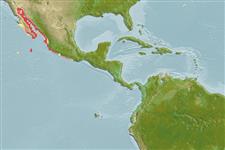Environment: milieu / climate zone / depth range / distribution range
Ecologie
marien rifbewoner; diepte 1 - 50 m (Ref. 5222). Tropical; 32°N - 18°N, 115°W - 102°W
Eastern Central Pacific: southwest coast of Baja California throughout the Gulf of California to Jalisco, Mexico.
Grootte / Gewicht / Leeftijd
Maturity: Lm ? range ? - ? cm
Max length : 86.0 cm TL mannelijk / geslacht onbekend; (Ref. 40637); max. gepubliceerd gewicht: 9.6 kg (Ref. 40637)
Dorsale stekels (totaal): 11; Dorsale zachte stralen (totaal): 16-18; Anale stekels 3; Anale zachte stralen: 10 - 11. Distinguished by the following characteristics: greenish to greyish brown body color with small reddish brown spots and irregular pale spots and lines; fins with white margins; small portion of population exhibit xanthic pattern which is entirely bright yellow-orange, sometimes with few irregular black spots; depth of body contained 2.7-3.1 times in SL; head length 2.6-2.8 times in SL; angle of preopercle in adults with weakly-developed serrate lobe; posterior nostrils of large adults 2-3 times larger than anterior ones (Ref. 89707).
Prefers rocky areas in shallow water at depths of about 50 m. Adults feed on schools of the flatiron herring, Harengula thrissina, and anchoveta, Cetengraulis mysticetus when available; if not, on other schooling fishes or non-schooling fishes. Most feed at dawn and dusk, with a peak in activity about 20 minutes after sunset. Juveniles feed throughout the day on a variety of benthic fishes and crustaceans.
Levenscyclus en paargedrag
Maturiteit | Voortplanting | Paaien | Eieren | Fecunditeit | Larven
Heemstra, P.C. and J.E. Randall, 1993. FAO Species Catalogue. Vol. 16. Groupers of the world (family Serranidae, subfamily Epinephelinae). An annotated and illustrated catalogue of the grouper, rockcod, hind, coral grouper and lyretail species known to date. Rome: FAO. FAO Fish. Synop. 125(16):382 p. (Ref. 5222)
Status op de Rode Lijst van het IUCN (Ref. 130435)
Gevaar voor de mens
Harmless
Gebruik door de mens
Visserij: van minder commercieel belang
Meer informatie
ReferentiesAquacultuurAquacultuurprofielKweeklijnenGeneticaElectrophoresesErfelijkheidZiektesVerwerkingNutrientsMassaconversie
Tools
Speciale rapporten
Download XML
Internetbronnen
Estimates based on models
Preferred temperature (Ref.
123201): 20.6 - 26.8, mean 22.4 °C (based on 24 cells).
Fylogenetische diversiteitsindex (Ref.
82804): PD
50 = 0.5000 [Uniqueness, from 0.5 = low to 2.0 = high].
Bayesian length-weight: a=0.00933 (0.00429 - 0.02028), b=3.04 (2.87 - 3.21), in cm total length, based on LWR estimates for this Genus-body shape (Ref.
93245).
Trofisch niveau (Ref.
69278): 4.5 ±0.80 se; based on food items.
Generation time: 11.9 ( na - na) years. Estimated as median ln(3)/K based on 1
growth studies.
Weerstandsvermogen (Ref.
120179): laag, minimale populatieverdubbelingstijd 4,5-14 jaar (K=0.09).
Fishing Vulnerability (Ref.
59153): High to very high vulnerability (67 of 100).
Nutrients (Ref.
124155): Calcium = 22.1 [13.6, 39.6] mg/100g; Iron = 0.449 [0.244, 0.783] mg/100g; Protein = 18.6 [16.8, 20.3] %; Omega3 = 0.131 [0.083, 0.208] g/100g; Selenium = 35.6 [18.8, 68.7] μg/100g; VitaminA = 137 [45, 467] μg/100g; Zinc = 0.808 [0.556, 1.143] mg/100g (wet weight);
